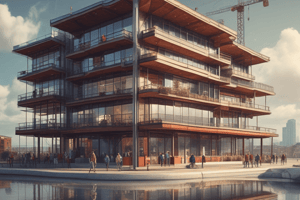Podcast
Questions and Answers
Match the building envelope functions with their descriptions:
Match the building envelope functions with their descriptions:
Control Function = The ability of a building envelope to control and moderate the exchange of mass and energy Finish Function = The aesthetics of the finished surface, the visual, textural, and other aspects Distribution Function = The ability of a building envelope to control and moderate the exchange of mass and energy
Match the following terms with their definitions:
Match the following terms with their definitions:
Aesthetics = A design's pleasing qualities Decay = Gradually becoming bad or weak due to natural causes Weathering = The process of water moving from one place to another Moisture Transfer = The action of weather conditions altering the color or texture of objects
Match the building codes with their descriptions:
Match the building codes with their descriptions:
National Building Code of the Philippines = A referral code to the NBC that seeks to improve the efficiency of building performance Philippine Green Building Code = Concerned with the acceptable standard designs for building envelopes National Structural Code of the Philippines = A referral code to the NBC that provides standards for building structures
Match the following factors with their effects on aesthetics:
Match the following factors with their effects on aesthetics:
Match the exchanges with their environments:
Match the exchanges with their environments:
Match the building envelope functions with their aspects:
Match the building envelope functions with their aspects:
Match the following sources of moisture with their descriptions:
Match the following sources of moisture with their descriptions:
Match the building codes with their purposes:
Match the building codes with their purposes:
Match the following transport processes with their descriptions:
Match the following transport processes with their descriptions:
Match the following terms with their associations:
Match the following terms with their associations:
Match the building envelope aspects with their descriptions:
Match the building envelope aspects with their descriptions:
Match the following terms with their effects on building materials:
Match the following terms with their effects on building materials:
Match the following terms with their corresponding definitions:
Match the following terms with their corresponding definitions:
Match the following types of loads with their descriptions:
Match the following types of loads with their descriptions:
Match the following terms with their corresponding descriptions:
Match the following terms with their corresponding descriptions:
Match the following types of walls with their descriptions:
Match the following types of walls with their descriptions:
Match the following terms with their corresponding descriptions:
Match the following terms with their corresponding descriptions:
Match the following terms with their corresponding descriptions:
Match the following terms with their corresponding descriptions:
Match the sustainable design principles with their descriptions:
Match the sustainable design principles with their descriptions:
Match the building envelope components with their functions:
Match the building envelope components with their functions:
Match the energy-efficient strategies with their purposes:
Match the energy-efficient strategies with their purposes:
Match the sustainable design elements with their benefits:
Match the sustainable design elements with their benefits:
Match the building envelope aspects with their importance:
Match the building envelope aspects with their importance:
Match the sustainable design strategies with their goals:
Match the sustainable design strategies with their goals:
Match the flowing concept with its definition:
Match the flowing concept with its definition:
Match the factors with their effects on durability:
Match the factors with their effects on durability:
Match the importance of durability with its consequences:
Match the importance of durability with its consequences:
Match the consequence of poor durability with its impact:
Match the consequence of poor durability with its impact:
Match the durable building characteristic with its benefit:
Match the durable building characteristic with its benefit:
Match the importance of durability with its relevance:
Match the importance of durability with its relevance:
Flashcards are hidden until you start studying





